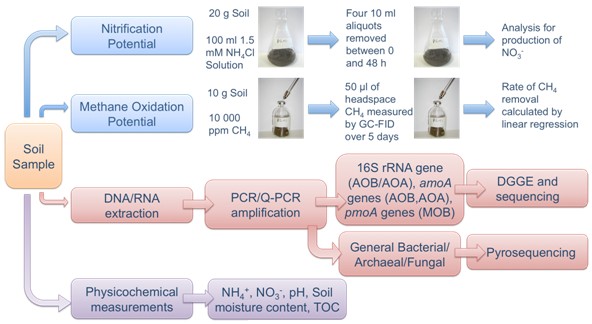Summary
Emma Thorpe, PhD studentship, University of Essex (2007-2011)
Summary
This study investigated the community composition and activity rates of two important groups of microorganisms – the ammonia oxidisers and the methane oxidising bacteria – at Hockham Heath as well as at a non N-impacted site, Alice Holt, Surrey.
Background
- Hockham Heath at Thetford Forest is characterised by high levels of NH4+ deposition due to the proximity of pig and chicken farms.
- A gradient of NH4+ and NO3– has been identified on a 300 m transect through the Corsican Pine and Beech plots.
- Ammonia oxidising bacteria (AOB) and archaea (AOA) are responsible for the first, rate-limiting step in nitrification- ammonia oxidation – which results in the production of NO3–.
- An increase in NH4+ deposition may lead to increased rates of ammonia oxidation and NO3– production. Whilst NH4+ is bound to the soil matrix, NO3– is soluble and susceptible to leaching, leading to a loss in N from the soil and pollution of surface and groundwater systems.
- Additionally, NH4+ and NO3– have been indicated as inhibitors of methane oxidation.
- Methane oxidation by methane oxidising bacteria (MOB) is the only known biological sink for methane, a potent greenhouse gas.
- It is therefore important to determine the impact of elevated NH4+ and NO3– concentrations on methane oxidation.
Research Objectives
To identify the community structure, abundance and activity of MOB, AOB and AOA in forest soils subject to increasing nitrogen deposition (NH4+ and NO3–) in relation to tree species, Corsican Pine (Pinus nigra) and Beech (Fagus sylvatica).
Hypothesis
- Where NH4+ and NO3– concentrations are high, methane oxidation potential will be inhibited and nitrification stimulated.
- Along the soil N gradient, changes in community structure and abundance of AOB, AOA and MOB may result in changes in the overall in situ biogeochemical cycling of C and N.
- Seasonal variation, pH and tree species may select for particular AOB, AOA and MOB genotypes which will influence methane oxidation and nitrification potential within the soils.
Method Overview

Our Involvement
This research was undertaken by Emma Thorpe at University of Essex, with supervision by Dr. Elena Vanguelova at Forest Research.
